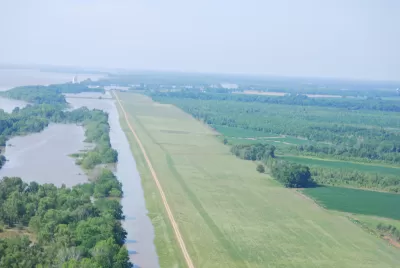A $50 billion plan to replenish lost coastal land could have significant impacts on local marine life and fishing industries.

The U.S. Army Corps of Engineers has released the environmental impact statement that allows a key component of a massive coastal restoration project planned for the Louisiana coast to move forward. Writing in the New York Times, John Schwartz reports that the Corps called the proposed project largely beneficial but expressed concern for the effects it could have on marine life.
The Mid-Barataria Sediment Diversion project is designed to replenish the sediment that has eroded away from Louisiana's coast, sediment that was naturally replenished before man-made levees contained the flow of the river. "If the corps issues final permits, which could happen as early as next year, a $1.4 billion structure will be dug into the western bank of the river below New Orleans. It will include gates that allow operators to control the flow of water and sediment from the mighty river into Barataria Bay, nearly an Olympic swimming pool’s worth of water every second."
To counter negative impacts, the project sets aside "millions of dollars to monitor dolphin populations and protect them, as well as helping to pay to relocate oyster beds to areas that will have the right level of salinity" and fund boat upgrades to help fishermen reach waters farther ashore. Acknowledging the dangers as well as the necessity of the project, Richie Blink, a council member of the Plaquemines Parish government, emphasized the importance of a safety net for "the people who are impacted most by the structure and the project." Opponents argue there are less destructive ways to stave off the effects of erosion, but those methods are more expensive and require more maintenance. Without the project, said Bren Haase, executive director of the state coastal authority, "the alternative is unthinkable. It’s a coastal Louisiana that doesn’t exist."
FULL STORY: Big Step Forward for $50 Billion Plan to Save Louisiana Coast

Maui's Vacation Rental Debate Turns Ugly
Verbal attacks, misinformation campaigns and fistfights plague a high-stakes debate to convert thousands of vacation rentals into long-term housing.

Planetizen Federal Action Tracker
A weekly monitor of how Trump’s orders and actions are impacting planners and planning in America.

San Francisco Suspends Traffic Calming Amidst Record Deaths
Citing “a challenging fiscal landscape,” the city will cease the program on the heels of 42 traffic deaths, including 24 pedestrians.

Defunct Pittsburgh Power Plant to Become Residential Tower
A decommissioned steam heat plant will be redeveloped into almost 100 affordable housing units.

Trump Prompts Restructuring of Transportation Research Board in “Unprecedented Overreach”
The TRB has eliminated more than half of its committees including those focused on climate, equity, and cities.

Amtrak Rolls Out New Orleans to Alabama “Mardi Gras” Train
The new service will operate morning and evening departures between Mobile and New Orleans.
Urban Design for Planners 1: Software Tools
This six-course series explores essential urban design concepts using open source software and equips planners with the tools they need to participate fully in the urban design process.
Planning for Universal Design
Learn the tools for implementing Universal Design in planning regulations.
Heyer Gruel & Associates PA
JM Goldson LLC
Custer County Colorado
City of Camden Redevelopment Agency
City of Astoria
Transportation Research & Education Center (TREC) at Portland State University
Jefferson Parish Government
Camden Redevelopment Agency
City of Claremont



























